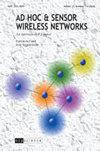基于Leach的智能家居节能协议
IF 0.6
4区 计算机科学
Q4 COMPUTER SCIENCE, INFORMATION SYSTEMS
引用次数: 0
摘要
在智能家居(SH)中,设备和电器可以通过互联网自动远程控制。智能家居中的传感器检测到变化,这些变化被处理并用于做出智能决策,例如自动打开灯。为了有效,智能家居的传感器必须连接起来,建立无线传感器网络作为智能家居功能的骨干。对于许多研究人员来说,无线传感器网络的性能面临着几个挑战。功耗是最关键的因素,因为节点需要电力来收集、处理和发送数据,但能量有限。为此,我们提出了一种基于LEACH协议的智能家居WSN改进协议EEP-LEACH (Energy Efficient protocol - Low Energy Adaptive Clustering Hierarchy)。利用Matlab对该算法进行性能分析,仿真结果表明,与其他协议相比,该算法的节点死亡时间更长,从而平衡了网络节点的能量消耗。本研究使用Python和Arduino进行一些模拟。本文章由计算机程序翻译,如有差异,请以英文原文为准。
An Energy-Efficient Protocol Based on Leach for Smart Home
In Smart Home (SH) the devices and appliances can be controlled automatically and remotely via the internet. Sensors in a smart home detect changes, which are processed and used to make intelligent decisions, such as automatically turning on the lights. To be effective, a smart home's sensors must be connected, establishing a wireless sensor network as the backbone for the smart home's functionalities. For many researchers, the performance of WSN faces several challenges. Power consumption is the most crucial factor since nodes require power to collect, process, and send data but have limited energy. As a result we propose an improved protocol for WSN in smart homes called EEP-LEACH (Energy Efficient Protocol - Low Energy Adaptive Clustering Hierarchy) based on the LEACH protocol. Matlab was used for the algorithm's performance analysis, and the simulation result showed that, compared to others protocols the death time of the nodes was longer, thus managing to balance the consumption of energy of the network nodes. Python and Arduino are used in this research to perform some simulations.
求助全文
通过发布文献求助,成功后即可免费获取论文全文。
去求助
来源期刊

Ad Hoc & Sensor Wireless Networks
工程技术-电信学
CiteScore
2.00
自引率
44.40%
发文量
0
审稿时长
8 months
期刊介绍:
Ad Hoc & Sensor Wireless Networks seeks to provide an opportunity for researchers from computer science, engineering and mathematical backgrounds to disseminate and exchange knowledge in the rapidly emerging field of ad hoc and sensor wireless networks. It will comprehensively cover physical, data-link, network and transport layers, as well as application, security, simulation and power management issues in sensor, local area, satellite, vehicular, personal, and mobile ad hoc networks.
 求助内容:
求助内容: 应助结果提醒方式:
应助结果提醒方式:


